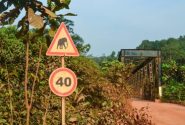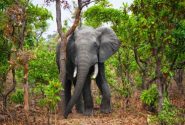BOGOR, Indonesia (26 September, 2012)_Policymakers seeking to conserve forests in southern India should focus on those that receive the highest levels of rainfall as these often harbor the greatest variety of plant species, says a new study by the Center for International Forestry Research.
But with climate change models predicting more intense and shorter rainfall periods in the region, effectively lengthening the dry season, the wet, biodiverse forest corridors are the ones most at risk – and the ones that should be prioritised in conservation schemes, said Shijo Joseph, CIFOR scientist and lead author of Rainfall and Elevation Influence the Local-Scale Distribution of Tree Community in the Southern Region of Western Ghats Biodiversity Hotspot (India).
And with forests rapidly disappearing, the recommendation is particularly timely as policymakers struggle to determine where to allocate limited resources for conservation.
“In South and South East Asian countries particularly, there is a high demand for land so we need to know what key environmental drivers are acting on the region to help prioritise land for conservation,” Joseph said.
To see how climate and elevation had affected plant diversity, scientists sampled the number and types of tree species in the Anamalai, located in southern India’s West Ghats region.
Though comprising only 6 percent of the country’s landmass, this biological hot spot is home to roughly a third of its species, many of which cannot be found anywhere else in the world. Of the more than 4,000 species of flowering plants found across the world 1,500 are endemic to the region.
As in humid, tropical forests of the Americas (also called the Neotropics) – where links between high rainfall and rich biodiversity are well-established – precipitation resulted in a greater number and variety of plant species, Joseph said.
The evergreen forests of Anamalai, which receive up to 4,500mm of rain annually held 81 species of tree, while the thorny scrub regions, which receive less than 400mm of rain annually, held only 27 species. While elevation, temperature, and slope also played a role, it was to a much lesser degree.
Scientists have documented the importance climate plays in the distribution of flora in Neotropical forests since the early 19th Century. But, reflecting the biases that characterise tropical biology, few such studies have been carried out in the drier, “Old World” forests of Asia and Africa, said Joseph.
It’s important to note, however, that the correlation between precipitation and biodiversity may not hold in all “Old World” tropics.
Some high rainfall areas such as Mt. Cherrapunji in the northeastern Indian state of Meghalaya, for instance, have been found to have relatively low plant species richness, Joseph and his co-authors wrote in the study, which appeared in the International Journal of Forestry Research.
And at least two sites in Africa’s Western Cameroon have more than twice the rainfall of parts of northeastern Gambon and only marginally more species.
But in most cases, rain plays a crucial role, that should not be ignored.
“While we cannot control rainfall itself, what we can do is conserve those landscapes that have high rainfall,” Joseph says.
“So instead of trying to influence precipitation, we can instead try to follow what nature is providing.”
This is not to say we should only focus on preserving the world’s rainforests, however.
“Systematic conservation planning should include all landscapes irrespective of species richness as the ultimate aim is to conserve a variety of species biodiversity,” Joseph says.
We want you to share Forests News content, which is licensed under Creative Commons Attribution-NonCommercial-ShareAlike 4.0 International (CC BY-NC-SA 4.0). This means you are free to redistribute our material for non-commercial purposes. All we ask is that you give Forests News appropriate credit and link to the original Forests News content, indicate if changes were made, and distribute your contributions under the same Creative Commons license. You must notify Forests News if you repost, reprint or reuse our materials by contacting forestsnews@cifor-icraf.org.











